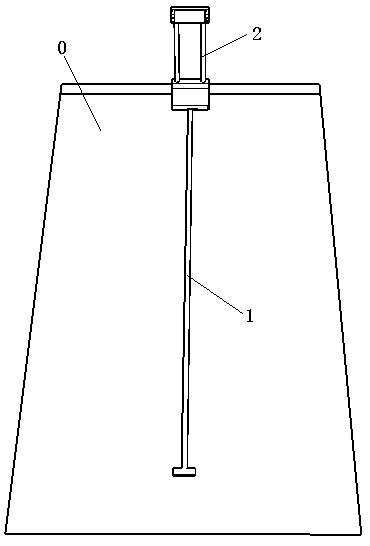Intelligent parking space protection method and robot
A technology for robots and parking spaces, applied in the fields of parking space management and robot control, can solve the problems of high requirements for robot motion control algorithms, crowded public parking, and no public parking space lock specific structure.
- Summary
- Abstract
- Description
- Claims
- Application Information
AI Technical Summary
Problems solved by technology
Method used
Image
Examples
Embodiment 1
[0041] Embodiment 1: Introduce a design scheme of a smart parking space guard robot based on magnetic strip positioning, such as figure 1 As shown, firstly bury the positioning magnetic strip (1) on the parking space (0); including: the positioning magnetic strip 1 (11) set at the end of the parking space (0), used to limit the robot (2) to walk to The position at the tail end of the parking space (0); the positioning magnetic strip (12) set near the longitudinal centerline of the parking space, used to limit the walking route of the robot (2); the limit magnetic strip set at the front end of the parking space (0) Two (13), used to limit the robot (2) to the front end of the parking space (0); figure 2 As shown, when the robot (2) is at the end of the parking space (0), the parking space (0) is unlocked, and the vehicle can park on the parking space (0); image 3 As shown, when the robot is parked at the front of the parking space (0), the parking space (0) is locked and veh...
Embodiment 2
[0042] Embodiment 2: Provide the anti-collision structure design of the above-mentioned or other realization forms of the robot (2), such as Image 6 As shown, the design of the walking path of the robot between the two parking spaces (0) is separated by a certain distance through the limit magnetic strip (11), leaving a parking space for the robot (2) between the parking spaces (0); Figure 7 with 8 As shown, the mobile base (21) of the robot (2) is designed to be L-shaped, which saves the space occupied by the parking space (0) and prevents the chassis of the car from touching the mobile base (21). The internal space reserved by the L-shape is convenient for installing the motor Further, in order to prevent the vehicle from bumping into the robot (2) when it enters the parking space (0), an infrared detector (221) can also be installed on the pole (22) of the robot (2) to emit infrared light and sense measure the distance to the vehicle, and when the distance is too close, ...
Embodiment 3
[0043] Embodiment 3: The walking design scheme of the intelligent parking space guard robot can also adopt the way of guide rails, such as Figure 10 As shown, the guide rail (3) for the robot (2) to walk is set on the parking space (0), and the installation relationship between the guide rail (3) and the robot (2) is as follows Figure 11 with 12 As shown, the bottom of the mobile base (21) of the robot (2) is provided with a positioning groove (213), a positioning rack (214) is arranged on the side, and a sliding groove (31) is arranged on the guide rail (3), and the sliding groove ( 31) Do not protrude from both ends of the guide rail (3), the positioning rack (214) is limited in the sliding groove (31), thereby limiting the movement path of the robot (2) and the positioning of both ends, and can be locked after reaching both ends The robot (2) and the guide rail (3) can be customized by relevant companies, and can be installed on the parking space (0) using expansion bolt...
PUM
 Login to View More
Login to View More Abstract
Description
Claims
Application Information
 Login to View More
Login to View More - R&D
- Intellectual Property
- Life Sciences
- Materials
- Tech Scout
- Unparalleled Data Quality
- Higher Quality Content
- 60% Fewer Hallucinations
Browse by: Latest US Patents, China's latest patents, Technical Efficacy Thesaurus, Application Domain, Technology Topic, Popular Technical Reports.
© 2025 PatSnap. All rights reserved.Legal|Privacy policy|Modern Slavery Act Transparency Statement|Sitemap|About US| Contact US: help@patsnap.com



